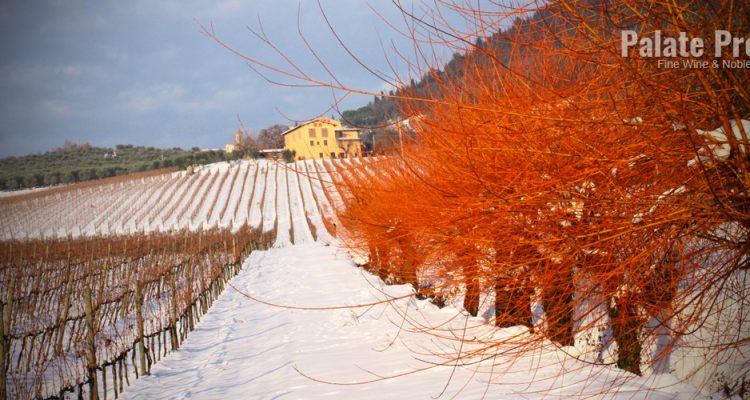Have Chianti wines gotten that much better, these days?
Apparently, the red sangiovese wines have always been amazing in Chianti Rùfina, the little-known northwestern region near Florence. As I’ve been learning (virtually) from the fourth-generation owner of I Veroni winery.
It’s simple to get to this winery. You can take the train about five miles from Florence to I Veroni – and stay there for a week, in the midst of the vineyards. You can rent one of the eight renovated apartments in their historic farm manor, and just relax. Walk the vineyards, lie out by the pool. Reserve a wine-and-food pairing class, or sit back and enjoy meals created by a local chef.
This is the brainchild Lorenzo Mariani, current proprietor of his family’s hundred-year-old vineyard property, located in Chianti Rùfina. As Lorenzo tells it, Chianti Rùfina’s proximity to Florence has made this a favored source of wine for city dwellers since the Middle Ages.
For centuries, only the wealthiest people could afford the fine wines of Chianti Rùfina. But even the poorer residents purchased the lesser quality wines – using them to disinfect their drinking water. Really.
Because centuries ago wines were transported by oxcart, it was important for a winery to be known and appreciated by the nearest customers. Present day, when Lorenzo recruited an old friend, Luca Innocenti, to help him grow I Veroni winery twenty years ago, this is the concept they embraced: They decided to become part of Florence’s current hospitality sector. Which involved Luca driving around the historic streets of the city on his old Vespa, carrying tasting samples of the wines to dozens of restaurants and wine shops.
It worked. I counted three dozen names of Florentine restaurants and shops on the winery’s convenient map. Some of the restaurants are hundreds of years old, still serving traditional recipes paired with these “local” Tuscan wines. And I Veroni has gone from producing a thousand bottles a year to 150,000.
This area is different from Chianti Classico region further south, in that these northerns producers make more traditional wines. Chianti Rùfina has been a favored region since 1716, when Cosimo III de Medici defined the quality vineyard areas in Tuscany. Here, the wines must be made with at least 75% sangiovese grapes, and some are 100% sangiovese. If there is any blending, it is mostly with indigenous grapes such as cannaiolo, trebbiano and malvasia. Yes, 10% of white grapes are still allowed in the blend – a concept I’ve always appreciated because I feel like I’m tasting wines the way they were made historically.
Lorenzo and Luca of I Veroni define this wine style as bright red in color, dry, with black cherry flavors and hint of violets in the aroma. With ageing, the wines become soft and elegant, taking on an orange hue. In fact Chianti Rùfina wines are said to be among the longest ageing wines in Chianti.
Chianti Rùfina is also the smallest DOCG sub-zone of Chianti. The grapes are mainly grown at higher altitudes, in the hills outside Florence. Due to climate change, Luca and Lorenzo have been replanting their vineyards, re-orienting them to face more northeast than south. Still, harvest is now three or four weeks earlier than it was a few decades ago.
Rùfina producers recently created an optional Lorenzo Mariani designation for their top wines. Among other requirements, wines with this label must be 100% Sangiovese and made from organic, estate vineyards. They must be Riserva quality, aged at least 30 months: a minimum of 18 months in oak, and 6 months in bottle. Thirteen producers signed on to the inaugural vintage in 2018; today the number has nearly doubled.
Since I’m not in Tuscany at the moment, Lorenzo and Luca sent out a couple bottles of their most well known wines to sample with them on zoom. After I sampled them, I was astounded when I discovered such reasonable pricing in the US.
The 2021 I Dōmi Chianti Rùfina DOCG is 90% sangiovese and with the rest a combination of cannaiolo nero and colorino. Lorenzo calls it “very traditional”; this style of wine was created and bottled by his grandfather just after World War II. The wine has a good balance, he says, because it is aged in large Slavonian oak casks which do not overwhelm the fruit in the wine. It is bright with cherry and berry fruit, tannin and acidity, and goes best with food. [about $19]
The 2020 Quona has the TERRAELECTAE designation. It begins with the typical violet aroma. The wine has plenty of body but is also light and elegant, with dark berry fruit, nice acidity and a medium-long finish CHECK THIS. Luca told us this wine will continue to develop in the bottle for three days; he’s right, I tried it. {Around $26]
If you’re looking for these wines, I Veroni exports 45% of their production to the US, so you can find them in all major markets. But remember, Luca and Lorenzo advise, drink these wines “always with food.” They recommend pasta with meat ragu or mushrooms or aged Pecorino cheese. Or the classic Florentine Peposo stew – which I’m still trying to persuade my husband to make. Unless he wants to take me to Tuscany to sample the dish at one of the many restaurants that feature I Veroni wines.

